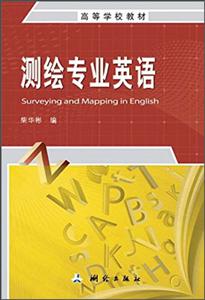-
>
宇宙、量子和人類心靈
-
>
氣候文明史
-
>
南極100天
-
>
考研數(shù)學(xué)專題練1200題
-
>
希格斯:“上帝粒子”的發(fā)明與發(fā)現(xiàn)
-
>
神農(nóng)架疊層石:10多億年前遠(yuǎn)古海洋微生物建造的大堡礁
-
>
聲音簡(jiǎn)史
測(cè)繪專業(yè)英語(yǔ) 版權(quán)信息
- ISBN:9787503037320
- 條形碼:9787503037320 ; 978-7-5030-3732-0
- 裝幀:一般膠版紙
- 冊(cè)數(shù):暫無(wú)
- 重量:暫無(wú)
- 所屬分類:>>
測(cè)繪專業(yè)英語(yǔ) 內(nèi)容簡(jiǎn)介
《測(cè)繪專業(yè)英語(yǔ)》涵蓋了測(cè)繪專業(yè)所涉及的主要知識(shí),包括測(cè)繪的基本概念、基本理論和基本操作技能,測(cè)繪儀器、測(cè)量方法、測(cè)量誤差及數(shù)據(jù)處理、工程測(cè)量、地圖制圖、全球定位系統(tǒng)、遙感和地理信息系統(tǒng)等測(cè)繪基礎(chǔ)知識(shí)。為了便于教師、學(xué)生和工程技術(shù)人員自學(xué),《測(cè)繪專業(yè)英語(yǔ)》每章*后都配有詞匯表。此外,以國(guó)家發(fā)布的測(cè)繪術(shù)語(yǔ)標(biāo)準(zhǔn)為依據(jù),給出常用測(cè)繪專業(yè)術(shù)語(yǔ)的英語(yǔ)詞匯表。 《測(cè)繪專業(yè)英語(yǔ)》面向?qū)W生,深入淺出,易學(xué)好用,結(jié)構(gòu)體系清晰合理,專業(yè)知識(shí)內(nèi)容豐富、系統(tǒng)全面,不僅適合測(cè)繪專業(yè)的本科生和研究生閱讀,也適合從事測(cè)繪工程專業(yè)的技術(shù)人員與研究人員閱讀或參考。
測(cè)繪專業(yè)英語(yǔ) 目錄
1.1 Introduction
1.2 Branches of surveying
1.2.1 Geodetic surveying
1.2.2 Plane surveying
1.2.3 Topographic surveying
1.2.4 Engineering surveying
1.2.5 Cadastral surveying
1.2.6 Hydrographic surveying
1.2.7 Mine surveying
1.3 Developments of surveying
1.3.1 Surveying techniques
1.3.2 Surveying equipments
1.3.3 Origin of Geomatics
1.4 Achievements of China's surveying
Chapter 2 Datums of Surveying
2.1 Introduction
2.2 Geoid and reference ellipsoid
2.2.1 Mean Sea Level and Geoid
2.2.2 Reference ellipsoid
2.3 Map projections
2.3.1 Three kinds of projections
2.3.2 Typical map projections
2.4 Datums and coordinate system
2.4.1 Horizontal and vertical datums
2.4.2 Coordinate systems
2.4.3 Coordinate conversions
Chapter 3 Distance Measurement
3.1 Introduction
3.2 Taping
3.3 Tacheometry
3.4 EDM measurement
Chapter 4 Elevation Measurement
4.1 Introduction
4.2 Leveling instruments
4.2.1 Ordinary level
4.2.2 Automatic level
4.2.3 Digital level
4.2.4 Laser level
4.3 Spirit leveling work
4.3.1 Principle of spirit leveling
4.3.2 Methods of spirit leveling
4.3.3 Refraction and curvature
4.4 Trigonometrie leveling
4.4.1 Instruments of trigonometric leveling
4.4.2 Principle of trigonometric leveling
4.4.3 Methods of trigonometric leveling
Chapter 5 Angle Measurement
5.1 Introduction
5.1.1 Horizontal angle
5.1.2 Vertical angle
5.2 Direetion and azimuth
5.2.1 Direction of line
5.2.2 Azimuth and bearing
5.3 Theodolite
5.3.1 Optical theodolite
5.3.2 Electronic theodolite
5.4 Angle measurement
5.4.1 Horizontal angle measurement
5.4.2 Vertical angle measurement
Chapter 6 Measurement Errors
6.1 Introduction
6.1.1 Sources of errors
6.1.2 Mistakes in measurements
6.2 Classifieations of errors
6.2.1 Systematic errors
6.2.2 Random errors
6.3 Analysis of random errors
6.3.1 Properties of random errors
6.3.2 Mean and standard deviation
6.3.3 Propagation of errors
6.4 Least—squares adjustment
6.4.1 Principles of adjustment
6.4.2 Models of adjustment
6.4.3 Adjustment methods
Chapter 7 Control Surveying
7.1 Control networks
7.1.1 Types of control networks
7.1.2 GPS control networks
7.1.3 Accuracy of control surveying
7.2 Triangulations and intersections
7.2.1 Triangulation methods
7.2.2 Intersection methods
7.3 Traversing
7.3.1 Classifications of traversing
7.3.2 Closures of traversing
7.3.3 Calculations of traversing
7.3.4 Traverse networks
7.4 Vertical control surveying
7.4.1 Differential leveling
7.4.2 Reciprocal leveling
7.4.3 Trigonometric leveling
Chapter 8 Engineering Surveying
8.1 New survey equipments
8.1.1 Total station
8.1.2 Laser rangefinder
8.1.33D laser scanner
8.1.4 Gyro—theodolite
8.2 Construction layout
8.2.1 Establishing control points
8.2.2 Construction layout
8.2.3 Techniques of layout
8.2.4 As—built surveys
8.3 Deformation monitoring
8.3.1 Deformation parameters
8.3.2 Monitoring schemes
8.3.3 Monitoring techniques
8.3.4 Reference network design
8.3.5 Monitoring data processing
8.4 Surface subsidence observation
8.4.1 Factors affecting surface subsidence
8.4.2 Subsidence observation lines
8.4.3 Frequency of subsidence surveys
8.4.4 Survey instruments and techniques
Chapter 9 Map and Cartography
9.1 Introduction
9.1.1 Map scale
9.1.2 Map elements
9.1.3 Map Types
9.2 Cartographic technology
9.2.1 Cartographic process
9.2.2 Map design
9.2.3 Computer—aided design
9.3 Developments of cartography
9.3.1 Technological advances
9.3.2 Cartographic software
9.3.3 Electronic maps
Chapter 10 Global Positioning System
10.1 Introduction
10.2 Basic principles of GPS
10.2.1 GPS positioning principle
10.2.2 GPS positioning methods
10.2.3 Error sources of GPS
10.3 Differential GPS
10.3.1 Differential principle
10.3.2 Differential processing
10.3.3 Accuracy of DGPS
10.4 RTK GPS technology
10.4.1 Basic principle of RTK
10.4.2 Cartier phase tracking
10.4.3 CORS Network of RTK
Chapter 11 Remote Sensing
11.1 Overviews
11.1.1 Concepts of RS
11.1.2 Types of RS platforms
11.1.3 Classifications of RS
11.1.4 Applications of RS
11.2 RS working principles
11.2.1 Electromagnetic energy
11.2.2 Interactions with the terrain
11.2.3 RS working process
11.3 Remote sensing data
11.3.1 Ground reference data
11.3.2 RS data acquisition
11.3.3 RS data formats
11.4 RS data processing
11.4.1 RS data interpretation
11.4.2 Digital RS image processing
11.4.3 Thematic Classification
11.4.4 RS data integrations
Chapter 12 Geographic Information System
12.1 Introduction
12.1.1 Components of GIS
12.1.2 Functions of GIS
12.1.3 Applications of GIS
12.2 Data structures
12.2.1 Raster Data Structures
12.2.2 Vector Data Structures
12.2.3 Comparisons of data structures
12.3 Data processing
12.3.1 Data input
12.3.2 Data preprocessing
12.3.3 Spatial analysis
12.4 Product generation
12.4.1 Map products
12.4.2 Image products
12.4.3 Statistical charts
12.4.4 Digital Terrain Model
References
Vocabulary
測(cè)繪專業(yè)英語(yǔ) 節(jié)選
《測(cè)繪專業(yè)英語(yǔ)》: Technical words and expressions: reference ellipsoid:基準(zhǔn)(參考)橢球面 mean sea level(MSL):平均海水面 equipotential surface:等勢(shì)面,等位面 mass anomaly:質(zhì)量異常 orthometric height:正高 geodetic azimuth:大地方位角 geodetic height:大地高 global geocentric ellipsoid:全球地心參考橢球 geodetic reference system 1980(GRS80):1980大地測(cè)量參考系統(tǒng) geoidal height:大地水準(zhǔn)面高 sea surface topography(SST):海面地形 map projection:地圖投影 orthogonal projection:正射投影 conformality:正形,正形性,保形性 meridian(line of longitude):子午線 parallel(line of latitude):平行線 equidistant projection:等距投影 arbitrary projection:任意投影 equal—area map:等(面)積投影 easel plane:承影面,投影面 conic projection:圓錐投影 normal axis tangent conic projection:正軸切圓錐投影 normal axis secant conic projection:正軸割圓錐投影 graticule:格子線;標(biāo)線;格網(wǎng) standard parallels:標(biāo)準(zhǔn)緯線 azimuthal projection:方位投影 planar projection:平面投影 transverse planar projection:橫軸平面投影 cylindrical projection:圓柱投影 transverse cylindrical projection:橫軸圓柱投影 oblique axis cylindrical projection:斜軸圓柱投影 Gauss—Kruger projection:高斯—克呂格投影 universal transverse Mercator(UTM) projection:通用橫軸墨卡托投影 transverse conformal secant cylindrical projection:橫軸等角割圓柱投影 ……
測(cè)繪專業(yè)英語(yǔ) 作者簡(jiǎn)介
柴華彬,男,1977年8月生,博士(后),河南理工副教授,研究生導(dǎo)師,河南省青年骨干教師。主要從事測(cè)繪、開(kāi)采沉陷方面的教學(xué)與科研工作。為研究生和本科生講授了《GIS原理與應(yīng)用》、《地理信息技術(shù)》、《測(cè)繪專業(yè)英語(yǔ)》、《礦山測(cè)量學(xué)》等課程。 主持和參與省教育規(guī)劃課題2項(xiàng),省廳級(jí)教改課題2項(xiàng)。2011年獲河南省教育科學(xué)研究成果二等獎(jiǎng)1項(xiàng),發(fā)表教育教學(xué)研究論文7篇。2006年獲得省級(jí)精品課程1門(mén)。作為主要成員,2007年獲得《測(cè)繪工程》教育部高等學(xué)校特色專業(yè),2008年獲得測(cè)繪工程河南省實(shí)驗(yàn)教學(xué)示范中心工作,2011年獲得測(cè)繪工程省級(jí)教學(xué)團(tuán)隊(duì)。 主持和參與完成國(guó)家自然科學(xué)基金3項(xiàng),省廳級(jí)項(xiàng)目9項(xiàng),橫向技術(shù)服務(wù)課題18項(xiàng),獲得河南省科技進(jìn)步二等獎(jiǎng)1項(xiàng),教育部高校科技獎(jiǎng)1項(xiàng),中國(guó)煤炭工業(yè)協(xié)會(huì)科學(xué)技術(shù)二等獎(jiǎng)2項(xiàng),三等獎(jiǎng)1項(xiàng)。發(fā)表學(xué)術(shù)論文70多篇,其中EI收錄16篇,ISTP收錄5篇。出版專著1部,規(guī)劃教材5部。
- >
中國(guó)人在烏蘇里邊疆區(qū):歷史與人類學(xué)概述
- >
人文閱讀與收藏·良友文學(xué)叢書(shū):一天的工作
- >
莉莉和章魚(yú)
- >
隨園食單
- >
月亮虎
- >
龍榆生:詞曲概論/大家小書(shū)
- >
我從未如此眷戀人間
- >
史學(xué)評(píng)論


















